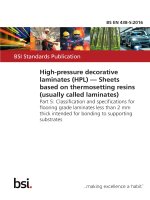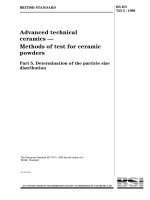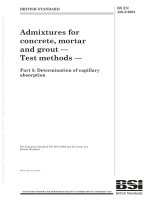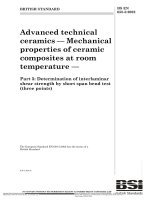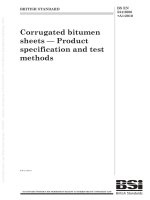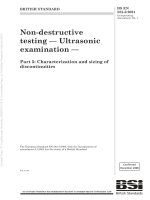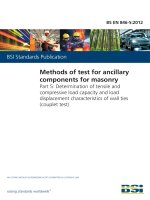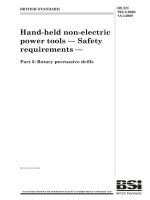Bsi bs en 61747 5 3 2010
Bạn đang xem bản rút gọn của tài liệu. Xem và tải ngay bản đầy đủ của tài liệu tại đây (2.23 MB, 24 trang )
BS EN 61747-5-3:2010
BSI Standards Publication
Liquid crystal display devices
Part 5-3: Environmental, endurance and mechanical
test methods — Glass strength and reliability
NO COPYING WITHOUT BSI PERMISSION EXCEPT AS PERMITTED BY COPYRIGHT LAW
raising standards worldwide™
BRITISH STANDARD
BS EN 61747-5-3:2010
National foreword
This British Standard is the UK implementation of EN 61747-5-3:2010. It is
derived from IEC 61747-5-3:2009. It supersedes DD IEC/PAS 61747-5-3:2007
which is withdrawn.
The CENELEC common modifications have been implemented at the
appropriate places in the text. The start and finish of each common modification
is indicated in the text by tags }~ .
The UK participation in its preparation was entrusted to Technical Committee
EPL/47, Semiconductors.
A list of organizations represented on this committee can be obtained on
request to its secretary.
This publication does not purport to include all the necessary provisions of a
contract. Users are responsible for its correct application.
© BSI 2010
ISBN 978 0 580 59788 6
ICS 31.120
Compliance with a British Standard cannot confer immunity from
legal obligations.
This British Standard was published under the authority of the Standards
Policy and Strategy Committee on 30 June 2010.
Amendments/corrigenda issued since publication
Date
Text affected
EUROPEAN STANDARD
EN 61747-5-3
NORME EUROPÉENNE
May 2010
EUROPÄISCHE NORM
ICS 31.120
English version
Liquid crystal display devices Part 5-3: Environmental, endurance and mechanical test methods Glass strength and reliability
(IEC 61747-5-3:2009, modified)
Dispositifs d'affichage à cristaux liquides Part 5-3: Méthodes d'essais
d'environnement, d'endurance
et mécaniques Résistance et fiabilité du verre
(CEI 61747-5-3:2009, modifiée)
Flüssigkristall-Anzeige-Bauelemente Teil 5-3: Verfahren zur Messung
von Glasfestigkeit und Zuverlässigkeit
(IEC 61747-5-3:2009, modifiziert)
This European Standard was approved by CENELEC on 2010-05-01. CENELEC members are bound to comply
with the CEN/CENELEC Internal Regulations which stipulate the conditions for giving this European Standard
the status of a national standard without any alteration.
Up-to-date lists and bibliographical references concerning such national standards may be obtained on
application to the Central Secretariat or to any CENELEC member.
This European Standard exists in three official versions (English, French, German). A version in any other
language made by translation under the responsibility of a CENELEC member into its own language and notified
to the Central Secretariat has the same status as the official versions.
CENELEC members are the national electrotechnical committees of Austria, Belgium, Bulgaria, Croatia, Cyprus,
the Czech Republic, Denmark, Estonia, Finland, France, Germany, Greece, Hungary, Iceland, Ireland, Italy,
Latvia, Lithuania, Luxembourg, Malta, the Netherlands, Norway, Poland, Portugal, Romania, Slovakia, Slovenia,
Spain, Sweden, Switzerland and the United Kingdom.
CENELEC
European Committee for Electrotechnical Standardization
Comité Européen de Normalisation Electrotechnique
Europäisches Komitee für Elektrotechnische Normung
Management Centre: Avenue Marnix 17, B - 1000 Brussels
© 2010 CENELEC -
All rights of exploitation in any form and by any means reserved worldwide for CENELEC members.
Ref. No. EN 61747-5-3:2010 E
BS EN 61747-5-3:2010
EN 61747-5-3:2010 (E)
–2–
Foreword
The text of the International Standard IEC 61747-5-3:2009, prepared by IEC TC 110, Flat panel display
devices, together with the common modifications prepared by the CENELEC Reporting Secretariat 110
(NL), was submitted to the CENELEC formal vote and was approved by CENELEC as EN 61747-5-3 on
2010-05-01.
Attention is drawn to the possibility that some of the elements of this document may be the subject of
patent rights. CEN and CENELEC shall not be held responsible for identifying any or all such patent
rights.
The following dates were fixed:
–
–
latest date by which the EN has to be implemented
at national level by publication of an identical
national standard or by endorsement
(dop)
2011-05-01
latest date by which the national standards conflicting
with the EN have to be withdrawn
(dow)
2013-05-01
Annex ZA has been added by CENELEC.
__________
–3–
BS EN 61747-5-3:2010
EN 61747-5-3:2010 (E)
Endorsement notice
The text of the International Standard IEC 61747-5-3:2009 was approved by CENELEC as a European
Standard with agreed common modifications.
BS EN 61747-5-3:2010
EN 61747-5-3:2010 (E)
–4–
Annex ZA
(normative)
Normative references to international publications
with their corresponding European publications
The following referenced documents are indispensable for the application of this document. For dated
references, only the edition cited applies. For undated references, the latest edition of the referenced
document (including any amendments) applies.
NOTE When an international publication has been modified by common modifications, indicated by (mod), the relevant EN/HD
applies.
Publication
Year
Title
EN/HD
Year
IEC 61747-1
-
Liquid crystal and solid-state display devices Part 1: Generic specification
EN 61747-1
-
IEC 61747-5
1998
Liquid crystal and solid-state display devices Part 5: Environmental, endurance and
mechanical test methods
EN 61747-5
1998
–5–
BS EN 61747-5-3:2010
EN 61747-5-3:2010 (E)
CONTENTS
INTRODUCTION..................................................................................................................... 6
1
Scope ............................................................................................................................... 7
2
Normative references ....................................................................................................... 7
3
Terms and definitions ....................................................................................................... 7
4
Abbreviated terms ............................................................................................................ 8
5
Apparatus ......................................................................................................................... 8
6
5.1
5.2
5.3
5.4
5.5
Test
7
6.1 General ................................................................................................................. 1 1
6.2 Parent glass .......................................................................................................... 1 2
6.3 Full size module .................................................................................................... 1 2
Procedure: Quasistatic loading ....................................................................................... 12
8
Stress calculations ......................................................................................................... 1 2
9
8.1 General ................................................................................................................. 1 2
8.2 Quasistatic biaxial strength (parent glass) ............................................................. 1 2
8.3 Quasistatic edge strength (parent glass) ............................................................... 1 3
8.4 Quasistatic failure load (LCD module) ................................................................... 1 3
Fatigue and reliability calculations .................................................................................. 1 3
General ................................................................................................................... 8
Method A: Quasistatic biaxial strength..................................................................... 9
Method B: Quasistatic edge strength (parent glass)................................................. 9
Method C: Quasistatic strength (module) ............................................................... 10
Method D: Fatigue constant................................................................................... 1 1
sample.................................................................................................................... 1 1
9.1 General ................................................................................................................. 1 3
9.2 Fatigue constant calculation .................................................................................. 1 4
9.3 Weibull parameter calculation from dynamic failure stress data ............................. 1 4
9.4 Fatigue constant calculation .................................................................................. 1 4
10 Reporting requirements .................................................................................................. 1 5
Annex A (informative) Worked test example ......................................................................... 1 6
Bibliography.......................................................................................................................... 1 9
Figure 1 – Schematic of ROR test fixture for measuring biaxial strength of parent glass ......... 9
Figure 2 – Vertical bend test fixture for measuring the edge strength of parent glass ............ 10
Figure 3 – Schematic of strength measurement for full-size LCD module .............................. 1 1
Figure A.1 – Weibull plot of biaxial strength of abraded glass with different thicknesses ....... 1 6
Figure A.2 – Fracture surface of parent glass with 0,089 mm mirror radius ........................... 1 7
Figure A.3 – Plot of calculated strength versus 1/square root of mirror radius ....................... 17
Figure A.4 – Weibull distribution of the strength of 17” module.............................................. 1 8
Table A.1 – Example of strength data before and after abrasion ........................................... 1 6
Table A.2 – Example of strength data for all modules and low strength modules ................... 1 8
BS EN 61747-5-3:2010
EN 61747-5-3:2010 (E)
–6–
INTRODUCTION
IEC 61747-5-3 facilitates the characterization of mechanical strength properties of LCD
modules and their component glass. Analysis and testing are performed on LCD Module
component glass as well as finished LCD modules. Statistics of mechanical strength of the
modules are determined allowing a prediction of module failure probability at a given stress
level or for a given probability of failure, the maximum recommended safe loading stress for
the module.
–7–
BS EN 61747-5-3:2010
EN 61747-5-3:2010 (E)
LIQUID CRYSTAL DISPLAY DEVICES –
Part 5-3: Environmental, endurance and mechanical test methods –
Glass strength and reliability
1
Scope
This part of IEC 61747 applies to commercially available liquid crystal displays (LCDs).
This standard applies to all LCD types, including transmissive, reflective or transflective liquid
crystal display (LCD) modules using either segment, passive or active matrix and achromatic
or colour type LCDs that are equipped with their own integrated source of illumination or
without their own source of illumination.
The objective of this standard is to establish uniform requirements for accurate and reliable
measurements of the following LCD parameters:
a) quasistatic strength,
b) quasistatic fatigue.
The methods described in this standard apply to all sizes, small and large, liquid crystal
displays.
NOTE Methods for measuring the fatigue constant are described in this standard and are taken from the
referenced literature, see [13] 1 to [20]. The primary results are formulae for estimated allowable stress for the
specified lifetime or estimated failure rate for the specified stress level. As an example, limited data for strength
and fatigue behaviour of LCD glass are included in an informative Annex A. Similarly, limited data for static
strength of LCD modules are also included and compared with that of parent glass.
2
Normative references
The following referenced documents are indispensable for the application of this document.
For dated references, only the edition cited applies. For undated references, the latest edition
of the referenced document (including any amendments) applies.
IEC 61747-1, Liquid crystal and solid-state display devices – Part 1: Generic specification
IEC 61747-5:1998, Liquid crystal and solid-state display devices – Part 5: Environmental,
endurance and mechanical test methods
3
Terms and definitions
For the purposes of this document, the following terms and definitions apply.
3.1
strength
stress at which a sample fails for a given loading condition
3.2
LCD surface strength
biaxial strength wherein surface flaws with different orientations are subjected to uniform
tension during measurement
———————
1
Figures in square brackets refer to the bibliography.
BS EN 61747-5-3:2010
EN 61747-5-3:2010 (E)
NOTE
–8–
Refer to [1] to [4] in the bibliography for further information.
3.3
LCD edge strength
uniaxial strength wherein edge flaws are subjected to tension during measurement
NOTE
Refer to [5] to [8] in the bibliography for further information.
3.4
LCD (mechanical) reliability
either an estimated allowable stress which the LCDs can sustain for a specified period of time
or as an estimated failure rate at a specified stress level
NOTE 1 Both approaches for quantifying the reliability of LCDs use the power law for slow crack growth and
require the knowledge of fatigue constant for the parent glass employed in the LCD displays.
NOTE 2
Refer to [9] to [12] in the bibliography for further information.
3.5
parent glass
sheet glass used as raw material for manufacturing of LCD panels and modules
4
Abbreviated terms
For the purposes of this document, the following abbreviations apply.
FC
filled cell
FEA
finite element analysis
FPD
flat panel display
LCD
liquid crystal display
} Text deleted ~
ROR
ring on ring
} Text deleted ~
VBT
5
5.1
vertical bend test
Apparatus
General
The parameters in the following figures are used in the stress formulas of Clause 8. The
dimensions are:
load (force), in newtons (N),
dimensions, in millimetres (mm),
stress, in megapascals (MPa).
The standard atmospheric conditions in IEC 61747-5, 1.4.3, shall apply, except that the
relative humidity shall be in excess of 95 % (vapour) unless otherwise specifically agreed
between the customer and the supplier.
NOTE In general, humidity can affect the measured strength, with higher humidity leading to decreased strength
values. For this reason, as well as to ensure consistency and reproducibility, the humidity level is stated at the
highest practical level.
BS EN 61747-5-3:2010
EN 61747-5-3:2010 (E)
–9–
5.2
Method A: Quasistatic biaxial strength
The quasistatic biaxial strength of parent glass is measured in the ring on ring (ROR) fixture
as shown in Figure 1. The dimensions of load and support rings are selected so as to
minimize large deflection and the associated membrane stress, especially for ultra-thin glass,
although the effect of such non-linearities on strength can be quantified using finite element
analysis (FEA), see the bibliographical references [21] to [24]. All ring surfaces in contact with
the test specimens should be rounded, with radii of 2 to 3 times the thickness of the glass
specimen. In general, certain trade-offs are necessary in designing the test specimen and
ROR fixture because the key objective is to measure quasistatic strength of as large a test
area as possible without introducing large nonlinearities. Alternatively a large sample quantity
is required to obtain the strength distribution representative of full size module. Since the
strength of glass surface is primarily dictated by the quality of that surface, i.e., surface
defects, it is imperative to measure the biaxial strength of those surfaces that have been
exposed to handling and processing damage during the fabrication of LCD devices. Such data
are then a good representation of LCD module strength.
Load
t (thickness)
6,25 mm radius
load ring
50 mm × 50 mm
specimens
r1
r2
12,5 mm radius
support ring
r3
IEC 545/09
Figure 1 – Schematic of ROR test fixture for measuring biaxial strength of parent glass
For square specimens, the specimen radius, r 3 , is the average of the inscribed and
circumscribed circles.
5.3
Method B: Quasistatic edge strength (parent glass)
Quasistatic strength of the edges of parent glass is measured in the VBT fixture shown in
Figure 2. The dimensions of glass specimen and test fixture are so chosen as to minimize
buckling of the top edge which is in compression during the test because the load is applied
from the top. As in the case of surface strength it is equally imperative that the edges of glass
specimens should have been exposed to handling and processing damage during the
fabrication of LCD devices. In addition the glass specimen should be large enough to
represent the full-size module.
BS EN 61747-5-3:2010
EN 61747-5-3:2010 (E)
– 10 –
L
O
A
D
P/2
P/2
l
t
h
P/2
L
P/2
IEC
546/09
Figure 2 – Vertical bend test fixture for measuring the edge strength of parent glass
5.4
Method C: Quasistatic strength (module)
The quasistatic strength of full size module is measured by supporting it on the mounting
points and loading it at the centre as shown in Figure 3. The loading point of the test fixture is
rounded and may be padded to avoid inducing additional flaws on the glass surface. Several
modules are tested in this manner to obtain a statistically significant strength distribution
representative of surface damage induced by handling, processing and fabrication of LCD
module. These data are also useful for estimating the module strength at orders of magnitude
lower failure probabilities. The same apparatus may also be used for loading the LCD module
off-centre and obtaining its strength at different locations.
– 11 –
BS EN 61747-5-3:2010
EN 61747-5-3:2010 (E)
P
IEC 547/09
Figure 3 – Photograph and schematic of strength measurement for full-size LCD module
5.5
Method D: Fatigue constant
The fatigue constant of parent glass is obtained by measuring its biaxial strength at four, or
more, different stress rates, each successive rate being one order of magnitude lower, using
the ROR fixture shown in Figure 1. A sample quantity of at least 25 specimens shall be used
at each of the stress rates to obtain a reliable value of fatigue constant. The specimens used
for this measurement should also have been exposed to handling and processing damage
representative of manufacturing of FC and LCD modules.
6
6.1
Test sample
General
Samples shall be representative of normal processes. The sample sizes indicated below are
minimal. Larger sample sizes will yield more accurate lifetime estimates.
BS EN 61747-5-3:2010
EN 61747-5-3:2010 (E)
6.2
– 12 –
Parent glass
A sample size of at least 50 specimens, each 50 mm × 50 mm, shall be used for measuring
quasistatic biaxial strength (see 5.2) of parent glass. A similar sample size shall be used for
characterizing abraded glass which simulates handling and processing damage.
The fatigue measurements are also carried out on 50 mm × 50 mm specimens prepared from
abraded glass. A sample size of at least 25 specimens shall be used at each of the stress
rates to obtain a fatigue constant value from regression analysis of strength versus stress rate
data.
6.3
Full size module
Full size modules and filled cells can range small to very large diagonal dimensions. In all
cases a minimum sample quantity of at least 25 filled cells or modules shall be used for
measuring biaxial strength under static loading (see 5.4). Such data then help determine
module strength at orders of magnitude lower failure probabilities.
Similarly, a sample quantity of at least 25 filled cells shall be used for measuring the edge
strength via the apparatus shown in Figure 2
7
Procedure: Quasistatic loading
The loading rate or crosshead speed for measuring the strength of either parent glass or filled
cell or full size module is so chosen as to complete the measurement in 30 s to 45 s. The
loading rate or crosshead speed shall be kept constant during this measurement.
8
Stress calculations
8.1
General
Stress calculations are used to normalize the load at failure to common stress units. This
normalization takes into account differences in glass material, dimensions, and some design
characteristics. For specimens of a common design and dimension, the failure load and
pressure rate can be substituted for failure stress and stress rate formulas of Clause 9.
Poisson’s ratio, ν , is a material property that is normally available from the material supplier,
but may be verified with material tests.
}8.2
Quasistatic biaxial failure stress (parent glass) ~
The strength of 50 mm × 50 mm specimens of parent glass tested in ROR fixture is calculated
from Equation (1).
σ max = [3P/4πt 2 ]×[2(1+ ν)ln(r 2 /r 1 ) + (1- ν)(r 2 /r 3 ) 2 (1-r 1 2 /r 2 2 )]
where
σ max
is the stress at failure,
P
is the failure load,
t
is the glass thickness,
ν
is the Poisson’s ratio,
r2
is the radius of support ring,
r1
is the radius of the load ring, and
r3
is the radius of the specimen.
(1)
BS EN 61747-5-3:2010
EN 61747-5-3:2010 (E)
– 13 –
}8.3
Quasistatic edge failure stress (parent glass)~
The edge strength of parent glass specimens is calculated from failure load P and
Equation (2).
σ e = 3P(L-l)/(2th 2 )
(2)
where
is the edge failure stress.~
}σe
h
is the height,
t
is the thickness,
l
is the load span,
L
is the support span, and
P
is the failure load.
8.4
Quasistatic failure load (LCD module)
For this test, the failure load and load rate are reported. While there are means to calculate
the failure stress, this calculation is very complex and involves design characteristics. The
failure load values from this test may be substituted into the failure stress in the equations of
Clause 9. Because failure load values are not normalized to stress, the results are valid only
for the size and design of module tested.
9
Fatigue and reliability calculations
9.1
General
The strength distribution resulting from tests are done at rates considerably higher than those
that are relevant to normal use. In addition, normal use will often reflect static load conditions
in which the probability of failure at a given time is desired. To link the test loading conditions
to the use conditions, the power law theory of fatigue is used. For tests at rates cited in this
document, the power law fatigue relationship for a single flaw is:
tF
}
∫σ
n
(t ) dt ≈ BS n − 2
~
(3)
0
where
} σ(t)
is the applied stress over time,
tF
is the time to failure,~
S
is the initial strength,
n
is the fatigue parameter,
B
is the strength preservation parameter.
The probability part of the relationship is based on the assumption that the initial strength
values follow a Weibull distribution that is given by
m⎤
⎡ ⎛
S ⎞ ⎥
⎟
1 − F = exp⎢− ⎜⎜
⎢ ⎝ S 0 ⎟⎠ ⎥
⎣
⎦
where
(4)
BS EN 61747-5-3:2010
EN 61747-5-3:2010 (E)
– 14 –
F
is failure probability,
S0
is the scaling parameter,
m
is the shape parameter.
NOTE Load and load rate are un-normalized stress values and may be substituted for stress values when the
specimen materials, dimensions, and design are common.
} 9.2
Dynamic fatigue calculation ~
The fatigue constant results from testing multiple samples to failure at multiple loading rates.
Let σ j represent the median failure stress of the j th rate and let σ& j represent the jth stress
rate. When the log of these values is plotted, a line is seen. The slope of the line is 1/(n+1).
That is, fit the following linear regression for the parameters, a and b:
ln(σ j ) = a + b ln(σ& j )
then n = 1/ b – 1
(5)
NOTE Alternative calculation methodologies can be found in ASTM C1368 [30]. However, in all cases, care
should be exercised in the interpretation of bimodal distributions.
9.3
Weibull parameter calculation from dynamic failure stress data
The data for this calculation is usually obtained from an experiment at a single stress rate and
uses the fatigue constant value derived from a different multiple stress rate experiment. The N
failure stress data values are sorted from minimum to maximum and indexed with k (from 1 to
N). }For each, the effective strength, SeffK is calculated as ~
ln(Seff k ) = −
1
n +1
ln[σ& ( n + 1) ] +
ln[σ k ]
n−2
n−2
(6)
The Weibull parameters are found by fitting the following linear regression
⎛
k − 0,3 ⎞ ⎞
⎛
ln⎜⎜ − ln⎜1 −
⎟ ⎟ = m ln(Seff k ) − m ln(Seff 0 )
N + 0,4 ⎠ ⎟⎠
⎝
⎝
} Seff0
(7)
is the Weibull scaling factor for Seff ~
The slope of the regression yields m and the intercept of the regression yields the composite
parameter on the right.
} 9.4
Extrapolated static fatigue and Weibull distribution calculation ~
This calculation uses the parameters already determined from 9.2 and 9.3. There are usually
three ways to ask reliability questions:
a) At a given probability of failure and static load what is the time to failure?
b) At a given static load and time to failure, what is the probability of failure?
c) At a given probability of failure and lifetime, what could the applied load be?
All these questions are evaluated using a different formulation for effective strength:
} ln (Seff) =
where
σ a is the applied load,
n
1
ln (t F ) ~
ln (σ a ) +
n−2
n−2
(8)
– 15 –
BS EN 61747-5-3:2010
EN 61747-5-3:2010 (E)
t F is the time to failure.
Any of the reliability equations can be evaluated rearranging the elements of the following
equation.
} ln(− ln(1− F )) + m ln(Seff0 ) =
mn
m
ln(σ a ) +
ln(t F ) ~
n−2
n−2
10 Reporting requirements
The following parameters shall be reported with the test results:
a) Type of specimens.
b) Sample quantity.
c) Sample size.
d) Testing rates.
e) Testing conditions including relative humidity of samples.
(9)
BS EN 61747-5-3:2010
EN 61747-5-3:2010 (E)
– 16 –
Annex A
(informative)
Worked test example
Figure A.1 shows the Weibull distribution [29] of biaxial strength of parent glass with abraded
surface representing handling and processing damage. Both 0,7 mm and 1,1 mm thick
glasses show nearly identical strength distribution, i.e. the strength of glass is dictated by
surface flaws and not by its thickness. The strength data before and after abrasion are
summarized in Table 1. Indeed the handling and processing damage can decrease the
strength of parent glass by 40 % to 50 %.
Failure probability (%)
99,5
98
95
90
80
Specimen thickness
0,7 mm
1,1 mm
60
40
20
10
5
2
350
300
225
250
200
175
150
125
100
1
Strength (MPa)
IEC 548/09
Figure A.1 – Weibull plot of biaxial strength of abraded glass with different thicknesses
Table A.1 – Example of strength data before and after abrasion
Thickness
mm
N
m
S0
MPa
0,7
30
3,9
404
1,1
50
3,7
460
0,7
20
6,4
228
1,1
19
7,3
233
As-received
Abraded
} The failure stress value can also be estimated by measuring the mirror radius, R m of the
specimen’s fracture surface, as shown in Figures A.2 and A.3, and using Equation (A.1).
. ~
BS EN 61747-5-3:2010
EN 61747-5-3:2010 (E)
– 17 –
IEC
549/09
Figure A.2 – Fracture surface of parent glass with 0,089 mm mirror radius
350
½
Strength via FEA (MPa)
300
Mirror constant = 65,3 ± 0,4 Mpa (mm)
250
200
150
100
50
0
0
1
2
3
½
1/(Mirror radius)
(mm
4
–½
)
5
IEC 550/09
Figure A.3 – Plot of calculated strength versus 1/square root of mirror radius
σ f = A/ Rm , A = 65,3 MPa m
} σf
(A.1)
is the failure stress for a given sample. ~
The biaxial strength data for 17” modules employing 0,7 mm glass are plotted as Weibull
distribution in Figure A.4. A bimodal distribution is obtained indicating two different families of
flaws introduced during fabrication of the modules. Table A.2 summarizes the strength data
and Weibull parameters.
BS EN 61747-5-3:2010
EN 61747-5-3:2010 (E)
– 18 –
Failure probability (%)
99,5
98
95
90
80
60
40
20
10
5
2
Strength (MPa)
800
900
700
600
500
400
300
200
1
IEC 551/09
Figure A.4 – Weibull distribution of the strength of 17” module
Table A.2 – Example of strength data for all modules and low strength modules
S0
N
m
All modules
23
4,6
582
Low strength modules
3
30,4
345
MPa
– 19 –
BS EN 61747-5-3:2010
EN 61747-5-3:2010 (E)
Bibliography
[1]
Dumbaugh, W. H. et al. “Glasses for Flat-Panel Displays.” High Performance Glasses.
Glasgow and London: Cable & Parker, Blackie and Son Limited, 1992.
[2]
Bocko, P.L. and Allaire, R. A. “Glass Contribution to Robustness of Displays for
Automotive Applications.” SID Symposium on Vehicle Displays, Detroit Metro Chapter.
Ypsilanti, MI: 1995
[3]
Gulati, S. T. “Relative Impact of Manufacturing vs. Service Flaws on Design of Glass
Articles.” Ceram. Trans. Vol. 50. 1995: pp. 79-94.
[4]
Lapp, J. C. "AMLCD Substrates: Trends in Technology.“ FPD Expo Taiwan. Hsinchu,
Taiwan: 2001
[5]
Helfinstine, J. D. and Gulati, S. T. American Ceramic Society, Fall Meeting. Pittsburgh,
PA: 2002.
[6]
Nattermann, K. “Edge strength testing for thin glass specimens at Schott Glas.”
International Commission on Glass TC6 Meeting. Prague: 1999.
[7]
Cleary, T. and Gulati, S.T., Fractography of Glasses and Ceramics IV. Westerville, OH:
J.R.Varner and G.D.Quinn, American Ceramic Society, 2001.
[8]
Akcakaya, R. and Gulati, S.T. International Commission on Glass. Amsterdam: 2000.
[9]
Ritter, J.E. et al. "Strength Degradation in Polycrystalline Alumina Due to Sharp-Particle
Impact Damage.“ Journal of the American Ceramic Society, Vol. 71, Iss. 12, 1988:
p.1154.
[10]
Evans, A.G. "Slow Crack Growth in Brittle Materials under Dynamic Loading
Conditions." International Journal of Fracture, Vol. 10, No. 2, June 1974: pp.251-259.
[11]
Wiederhorn, S.M. et al., Fracture Mechanics of Ceramics. New York: R.C.Bradt, Plenum
Press, 1976.
[12]
Wiederhorn, S. M. et al. “Application of Fracture Mechanics to Space-Shuttle
Windows.“ Journal of the American Ceramic Society, Vol. 57, No. 7, 1974: pp. 319-323.
[13]
Helfinstine, J. D. "Adding Static and Dynamic Fatigue Effects Directly to the Weibull
Distribution.“ Journal of the American Ceramic Society, Vol. 63, 1980: p.113.
[14]
Ritter, J. E., Jakus, K., Batakis, A. And Bandyopadhyay, N. “Appraisal of Biaxial
Strength Testing.“ Journal of Noncrystalline Solids, Vol. 38 & 39, 1980: pp. 419-424.
[15]
Ritter, J. E. and Sherburne, C. L. “Dynamic and Static Fatigue of Silicate Glasses,”
Journal of the American Ceramic Society, Vol. 54, Issue 12, 1971: pp.601-605.
[16]
Gulati, S. T. “Crack Kinetics during Static and Dynamic Loading.” Journal of NonCrystalline Solids, Vol. 38 & 39, Part I, May/June 1980: pp 475-480.
[17]
Helfinstine, J. D. and Gulati, S. T. “Fatigue and Aging Behavior of Active Matrix Liquid
Crystal Display Glasses.” SID Conference, Toronto: 1997.
[18]
Tummala, R. R. “Stress corrosion resistance compared with thermal expansion and
chemical durability of glass.” Glass Technology, Vol. 17, 1976.
[19]
Gulati, S. T. and Helfinstine, J. D. “Long-Term Durability of Flat Panel Displays for
Automotive Applications.” SID Digest, Vol. 27, 1996: pp 49-56.
[20]
Gulati, S. T. “Dynamic and Static Fatigue of Silicate Glasses under Biaxial Loading:
th
Application to Space Windows, CRT’s and Telescope Mirrors.” 5 International Otto
Schott Colloquium. Jena, Germany, 11-14 July 1994.
BS EN 61747-5-3:2010
EN 61747-5-3:2010 (E)
– 20 –
[21]
ANSYS Inc., Canonsburg, PA.
[22]
Gulati, S. T., Hansson, N, Helfinstine, J.D., and Malarkey, C.J. “Ceramic dies for hot
metal extrusion.” Tube International, March & June 1985.
[23]
Gulati, S. T., Nolan, D.A., and Janssen, Ch. “Thermal Stresses in Nonuniformly Heated
Glass Panels.” American Ceramic Society Glass Division Fall Meeting. Bedford Springs,
PA: 14-16 October 1981.
[24]
Gulati, S. T. and McCartney, J.S. “Experimental Verification of Proof Stress During
Flexure Tests on Space Shuttle Windows,” IASS World Congress on Space Enclosures.
Montreal: July 1976.
[25]
Shand, E. B. “Breaking Stress of Glass Determined from Dimensions of Fracture
Mirrors.” Journal of the American Ceramic Society. Vol. 42, Issue 10, October 1959:
pp.474-477.
[26]
Krohn, D. A. and Hasselman, D. P. H. “Relation of Flaw Size to Mirror in the Fracture of
Glass.“ Journal of the American Ceramic Society, Vol.54, Issue 8, 1971: p.411.
[27]
Mecholsky, J. J. et al. “Prediction of the fracture energy and flaw size in glasses from
the mirror size measurements.” Journal of the American Ceramic Society, Vol. 57,
No.10, 1974: pp.440-443.
[28]
Kerper, M. J. and Scuderi, T. G. “Modulus of Rupture in Relation to Fracture Pattern.”
Ceramic Bulletin, Vol. 43, No. 9, 1964.
[29]
Weibull, W. "A Statistical Distribution Function of Wide Applicability.“ Journal of Applied
Mechanics, Vol. 18, 1951: pp.293-297.
[30]
ASTM C1368, Standard Test Method for Determination of Slow Crack Growth
Parameters of Advanced Ceramics by Constant Stress-Rate Flexural Testing at Ambient
Temperature
______________
This page deliberately left blank
British Standards Institution (BSI)
BSI is the independent national body responsible for preparing British Standards
and other standards-related publications, information and services.
It presents the UK view on standards in Europe and at the international level.
It is incorporated by Royal Charter.
Revisions
Information on standards
British Standards are updated by amendment or revision. Users of British Standards should make sure that they possess the latest amendments or editions.
It is the constant aim of BSI to improve the quality of our products and services. We would be grateful if anyone finding an inaccuracy or ambiguity while
using this British Standard would inform the Secretary of the technical committee responsible, the identity of which can be found on the inside front
cover.
Tel: +44 (0)20 8996 9001 Fax: +44 (0)20 8996 7001
BSI provides a wide range of information on national, European
and international standards through its Knowledge Centre.
BSI offers Members an individual updating service called PLUS which ensures
that subscribers automatically receive the latest editions of standards.
Tel: +44 (0)20 8996 7669 Fax: +44 (0)20 8996 7001
Email:
Buying standards
You may buy PDF and hard copy versions of standards directly using a
credit card from the BSI Shop on the website www.bsigroup.com/shop.
In addition all orders for BSI, international and foreign standards publications
can be addressed to BSI Customer Services.
Tel: +44 (0)20 8996 9001 Fax: +44 (0)20 8996 7001
Email:
In response to orders for international standards, it is BSI policy to
supply the BSI implementation of those that have been published
as British Standards, unless otherwise requested.
Tel: +44 (0)20 8996 7004 Fax: +44 (0)20 8996 7005
Email:
Various BSI electronic information services are also available which
give details on all its products and services.
Tel: +44 (0)20 8996 7111 Fax: +44 (0)20 8996 7048
Email:
BSI Subscribing Members are kept up to date with standards
developments and receive substantial discounts on the purchase price
of standards. For details of these and other benefits contact Membership Administration.
Tel: +44 (0)20 8996 7002 Fax: +44 (0)20 8996 7001
Email:
Information regarding online access to British Standards via British
Standards Online can be found at www.bsigroup.com/BSOL
Further information about BSI is available on the BSI website at www.bsigroup.com/standards
Copyright
Copyright subsists in all BSI publications. BSI also holds the copyright,
in the UK, of the publications of the international standardization bodies. Except as permitted under the Copyright, Designs and Patents Act 1988 no extract may be reproduced, stored in a retrieval system or transmitted in any
form or by any means – electronic, photocopying, recording or otherwise –
without prior written permission from BSI. This does not preclude the free
use, in the course of implementing the standard of necessary details such as
symbols, and size, type or grade designations. If these details are to be used
for any other purpose than implementation then the prior written permission
of BSI must be obtained. Details and advice can be obtained from the Copyright & Licensing Manager.
Tel: +44 (0)20 8996 7070
Email:
BSI Group Headquarters
389 Chiswick High Road London W4 4AL UK
Tel +44 (0)20 8996 9001
Fax +44 (0)20 8996 7001
www.bsigroup.com/standards
raising standards worldwide™
